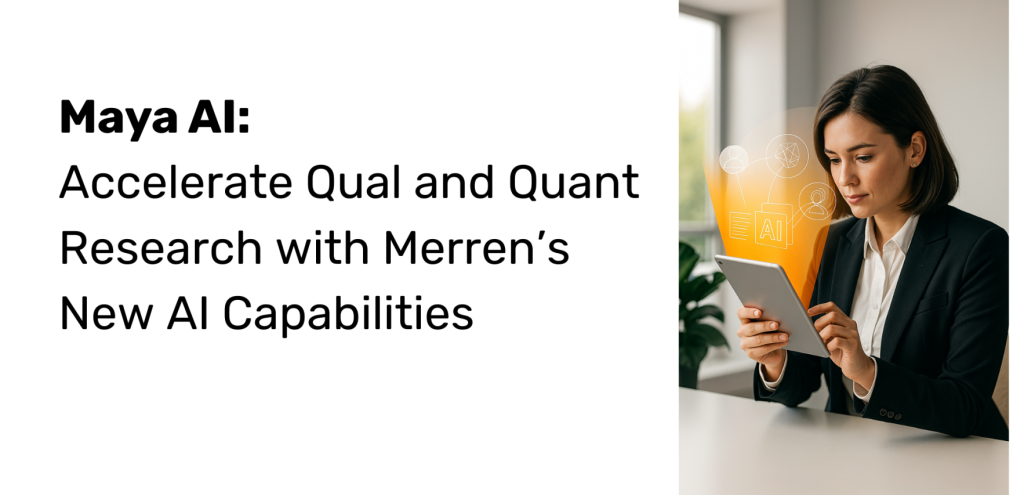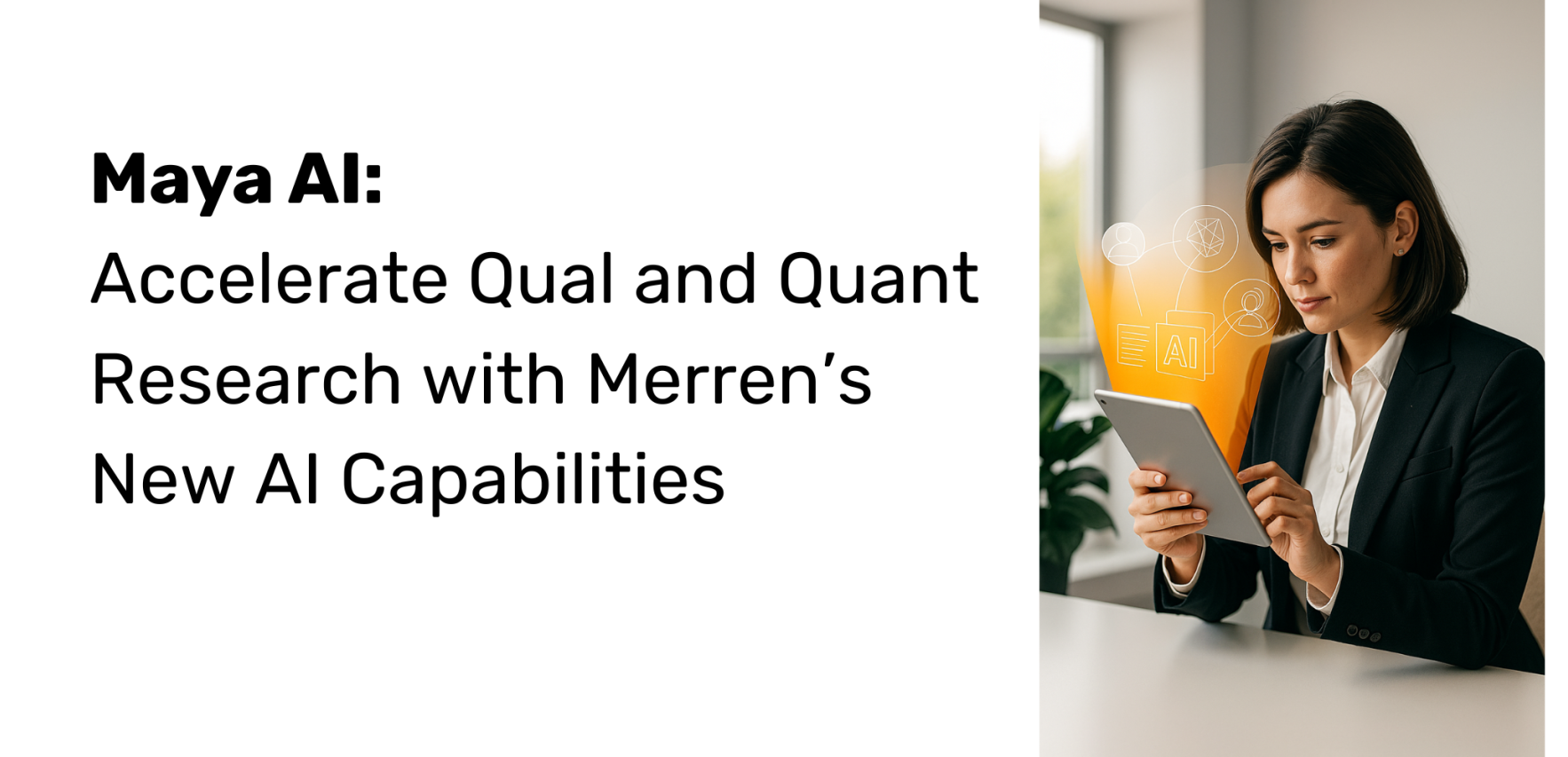Merren has built Maya AI with a new vision: accelerate qualitative and quantitative research at scale for businesses across multiple industries. Maya AI can conduct in-depth research that is powered by guided voice surveys. In this blog, we will tell you how Maya AI integrates with human expertise to bring you the best of both worlds.
What is Merren’s Maya AI
Maya is Merren’s AI-powered customer research tool built for quantitative and qualitative research. Maya conducts conversations with customers via voice or text across multiple languages and time zones so that businesses can gather nuanced, human-level insights at scale.
Researchers can use Maya AI to input a study objective and let the AI handle the process: designing discussion guides, recruiting participants, conducting real interviews, and analyzing results. Responses are captured in real time, transcribed, and synthesized into themes, sentiment, and key takeaways on the dashboard.
Maya’s dashboard delivers transcripts, insights, and highlights within hours, giving teams the ability to act quickly and confidently on customer feedback. Maya AI combines speed, scale, and depth, She eliminates the traditional trade-off between quality and efficiency in qualitative research.
How to Get Started With Maya AI
Define your research objective
Set your research goal (e.g., test product concepts, explore customer pain points). Upload context files if needed. Merren’s AI capabilities suggest key exploration areas so you don’t miss critical angles.
Identify key information areas (KIAs)
Review and refine auto-generated themes such as behavior, decision factors, or unmet needs. Add, edit, or reorder as required.
Build your discussion guide instantly
Maya generates open-ended questions tied to your KIAs. You can edit or add probes to make the guide dynamic and adaptive.
Collect responses from real people
Choose a persona (friendly, expert, empathetic, etc.), adjust voice settings, add pronunciations, select languages, and craft an opening message for authentic conversations. Deploy interviews via links, chat, or video platforms. Maya transcribes, analyzes, and synthesizes responses into themes and sentiment, delivering insights in hours, not weeks.
Qualitative depth with quantitative insight at your finger tips. Read more on how to set-up your own AI interviewer here: How to set-up AI interviews with Merren
AI-Interviewer for Market Research: 5 Reasons Why You Need Them
We built Maya because as former market researchers and marketers, we felt the pain of waiting weeks for qualitative insights. Conducting IDIs (in-depth interviews) was always a trade-off – do we invest a ton of time and money to get 20 great interviews, or do we skip it and risk decisions without deep feedback? With budgets tightening and markets going global, this trade-off got even harder
1. Create multiple simultaneous AI interviews
Maya AI compresses this timeline into hours by automating discussion guide creation, data collection, transcription, and analysis. For example: you can focus on segments targeting price discussions, brand awareness and customer experience post-purchase at the same time. You receive critical data from your customer base without the hassle of manual work. Researchers can move from objectives to actionable insights in the same week, keeping pace with rapidly shifting markets.
2. Scale research methodologies globally, effortlessly
Traditionally, conducting 20 interviews manually is costly and time-intensive; scaling to hundreds is almost impossible. Maya AI can run voice or text interviews simultaneously across multiple languages (32 different languages with Merren) across time zones. This means global perspectives are captured without the delays or costs of translation and local moderators.
3. Empowering researchers, not replacing them
Maya AI is not about replacing human skillsets with AI, it is about augmenting it. Maya handles the logistics: real participant interviews, analysis, and reporting so that researchers can focus on strategy and interpretation.This process will enable professionals to spend more time empathizing with customers and shaping decisions. Now researchers gain both efficiency and creative bandwidth to explore bold ideas.
4. Consistent quality in every interview
Human moderators vary in style, fatigue, and bias, which can affect data quality.
Maya AI ensures every participant experiences a consistent, empathetic and a tailored conversation. It can be through a friendly persona, expert voice, or neutral tone. This uniformity boosts reliability while still capturing authentic, human-level nuance.
5. Instant access to actionable insights
Maya’s dashboard provides transcripts, themes, sentiment analysis, and highlight reels in real time. Instead of waiting for manual coding or clustering, researchers can immediately identify patterns, pain points, and emerging trends.Get your results in days not weeks using an interactive presentation that will give you a synopsis of your data.
This enables agile decision-making teams to test, iterate, and refine quickly, turning research into a continuous feedback loop.
Create Your Own AI Interviewer with Maya AI Today
In 2025 and beyond, speed is everything. Markets shift overnight, and teams can’t afford to rely only on surveys or gut feeling when making big bets. At the same time, traditional qual research hasn’t caught up – it’s slow, pricey, and often localized. We’ve seen amazing advances in AI (LLMs, NLP) and thought: why not use these to conduct qualitative research at scale?
Maya will help you overcome this barrier with empathy, intuitive probing and interactive experience. Maya is upgrading and improving with every iteration. If you want to be a part of the pilot, send us an email here.

